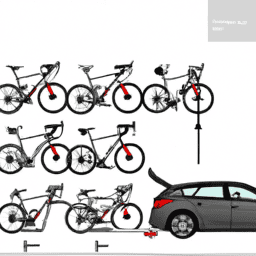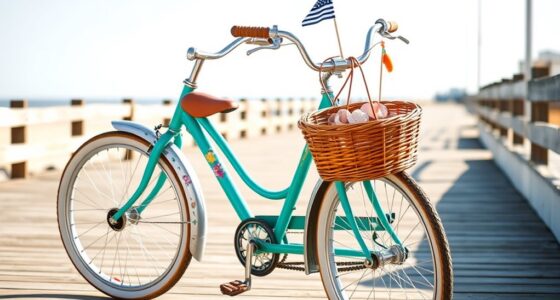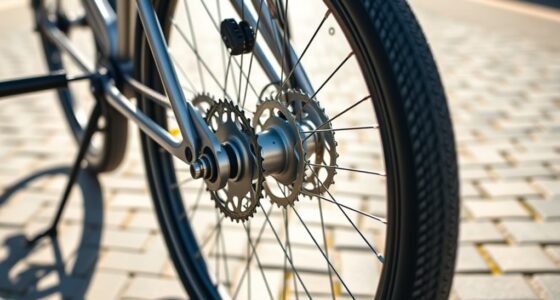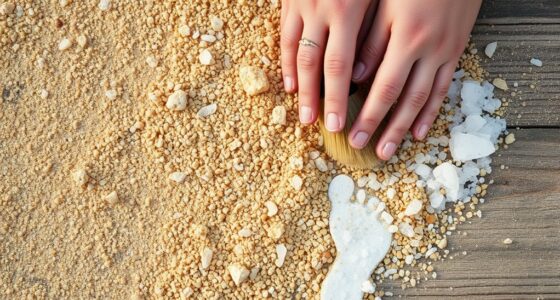Were you aware that bicycle ridership in the United States has surged by 64% in the last ten years? As cycling becomes a popular hobby and mode of transport for an increasing number of individuals, understanding the proper and safe ways to transport your bicycle is crucial.
One of the most common methods is putting your bicycle in your car, and in this article, we’ll guide you through the process step by step.
To begin, it’s important to choose the right equipment for the job. You’ll need a bike rack or carrier that’s compatible with your vehicle and can securely hold your bike in place. There are several types to choose from, including trunk-mounted, roof-mounted, and hitch-mounted racks.
Each has its pros and cons, so it’s important to do your research and choose the one that best fits your needs and budget. With the right equipment and a bit of preparation, you can safely transport your bike to your next destination.
Key Takeaways
- Choosing the right type of bike rack or carrier for the car is important.
- Proper preparation of the bike before transport, including checking tire pressure and removing accessories, is necessary.
- Loading and securing the bike onto the car should be done carefully, following manufacturer’s instructions and protecting the car’s interior from scratches and dirt.
- Safe driving practices, including defensive driving and securing loose items in the car, should be followed while transporting the bike.
Choose the Right Equipment
You’ll wanna make sure you’ve got the right equipment before trying to cram your bike into the back of your car. Bike rack options are a great solution to transporting your bike safely and securely.
There are a variety of bike racks available, including roof racks, trunk racks, and hitch racks. When choosing a bike rack, it’s important to consider your car’s compatibility. Some racks are specifically designed for certain car models, so make sure to check the rack’s compatibility before purchasing.
Additionally, consider how many bikes you need to transport and the weight capacity of the rack. Once you have the right equipment, you can move on to preparing your bike for transport.
Prepare Your Bike
Before cramming that two-wheeled speedster into your ride, make sure it’s stripped down to its bare bones. Start by checking the tires and ensuring they’re inflated to the proper pressure. This’ll not only prevent damage to your bike during transportation but also ensure a smooth ride once you’re ready to hit the road.
Next, remove any accessories such as water bottles, lights, or bike computers. These items can become loose during transportation and scratch or damage your car’s interior or your bike itself.
Once your bike is stripped down and ready to go, you can move on to the next step of loading it into your car and securing it properly for the journey ahead.
With your bike now stripped down and ready to go, it’s time to load it into your car.
Load Your Bike
Now that your bike is stripped of any accessories, it’s time to figure out the best way to load and secure it for a safe journey. Here are three bike rack options to consider:
-
Roof rack: This type of rack is mounted on the roof of your car and can hold one or more bikes. It’s a great option if you have a tall vehicle or want to keep your trunk space free. However, it can be challenging to lift the bike onto the roof and secure it safely.
-
Hitch rack: This rack is attached to the hitch receiver on the back of your car and can hold multiple bikes. It’s easy to install and use, but it can make it difficult to access your trunk while the bikes are loaded.
-
Trunk rack: This option attaches to the trunk of your car and can hold one or more bikes. It’s the most affordable option, but it can scratch your car’s paint and may not fit securely on all vehicles.
No matter which bike rack option you choose, it’s important to protect your car’s interior from scratches and dirt. Consider using a protective cover or towel to place over the bumper and trunk area.
Once your bike is loaded and secured, it’s time to hit the road and drive safely to your destination.
Drive Safely
As you’re traveling with your bike, it’s essential to remember to drive safely and be aware of your surroundings. Practice defensive driving by maintaining a safe following distance and avoiding sudden stops or turns. Keep in mind that your car’s handling will be affected by the added weight of the bike, so take turns and corners slowly and carefully.
In addition, make sure to secure any loose items in your car. A sudden stop or collision could cause these items to become dangerous projectiles. Double-check that your bike is securely fastened and won’t shift during the drive. By taking these precautions, you can ensure a safe and stress-free journey with your bike.
As you prepare to unload your bike, keep in mind the following tips.
Unload Your Bike
To safely unload your bike, make sure it’s in a stable position and that all straps and fastenings are released. Start by opening the car trunk or hatchback and removing any items that may be in the way. Then, carefully lift the bike out of the car, making sure to keep it balanced and steady. If you have a bike rack, follow the manufacturer’s instructions for removing the bike from the rack.
Once the bike is out of the car, it’s important to properly store it to prevent damage and ensure its longevity. This includes cleaning the bike, checking for any damage or wear and tear, and performing any necessary bike maintenance. Proper storage can also help prevent theft, so make sure to lock up your bike in a secure location when not in use. By taking these steps, you can safely and effectively unload your bike from your car and keep it in top condition for your next ride.
| Bike Maintenance Checklist | Frequency |
|---|---|
| Clean bike frame and components | After every ride |
| Check tire pressure | Before every ride |
| Lubricate chain | Every 100-200 miles |
| Check brake pads for wear | Every 500 miles |
| Check for loose bolts and screws | Every 500 miles |
Frequently Asked Questions
Can I put more than one bike in my car?
Yes, you can transport multiple bikes in your car, but it’s important to follow group cycling etiquette and choose the best bike racks for the job. Look for racks that can hold multiple bikes securely and consider the weight capacity of your car’s roof or trunk.
What do I do if my bike doesn’t fit in my car?
If your bike doesn’t fit in your car, consider bike rack solutions. 64% of Americans live within 2 miles of a bikeable trail or park. Alternatively, explore alternative transportation options such as public transit or ride sharing.
Can I transport my bike without taking off the wheels?
To transport your bike without wheel removal, consider alternative methods such as folding the bike or using a bike rack. When securing the bike inside the car, use padding and straps to prevent damage and ensure it is stable during transport.
Is it safe to put a bike in the trunk of a car?
You may be tempted to toss your bike in the trunk, but it can cause damage. Consider bike rack alternatives or securing your bike in the car with straps. Be technical and precise to avoid mishaps.
Will my bike get damaged during transportation?
To protect your bike during transportation, use appropriate methods such as securing it with straps and padding. Avoid placing heavy items on top of the bike and make sure the car is clean to prevent scratches.
Conclusion
Congratulations! You’ve successfully learned how to put your bicycle in your car. By following the steps outlined in this article, you can safely transport your bike and enjoy your next adventure.
Remember to choose the right equipment, prepare your bike, and load it carefully. Secure it properly to avoid any damage during transit. As you drive, be mindful of your bike’s presence and take necessary precautions to ensure a safe journey.
Once you reach your destination, don’t forget to unload your bike with care. Whether you’re a seasoned cyclist or a beginner, transporting your bike in your car can be a daunting task. But with the right knowledge and a little practice, you can do it effortlessly.
So gear up and hit the road with your trusty bike, knowing that you have what it takes to transport it like a pro!
In conclusion, this article has equipped you with the necessary information to put your bike in your car like a pro. From choosing the right equipment to driving safely, you now have a clear understanding of how to transport your bike with ease. So go ahead and take your bike on your next adventure, knowing that you have the skills to move it from one place to another with confidence.
With these tips, you’ll be able to transport your bike like a superhero, saving the day and keeping your bike safe and sound.









